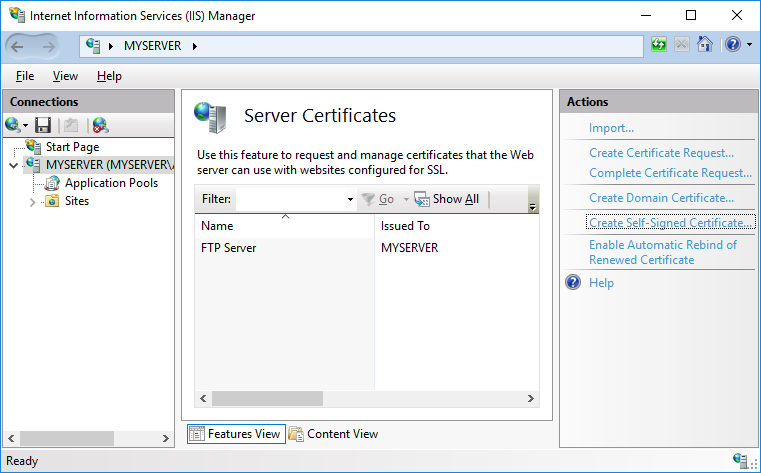Welcome to our blog post about Windows FTP Server! FTP (File Transfer Protocol) servers allow you to share or host data on your computer that might be too large to transfer through email. This guide will walk you through the steps of setting up an FTP server on a Windows machine.
First, you will need to open the Server Manager window by clicking on the taskbar icon. Once open, click on the Manage menu and then select Add Roles and Features. In the wizard that appears after clicking, select Next until you reach the Server Roles page. Here, expand Web Server (IIS) and check off FTP Server. Click Next again when prompted and then Next one final time on the Select Features page.
Now that you have enabled the FTP server, it’s time to install IIS Management Console so that you can manage your server from a web interface. To do this, go to the Roles node in the Windows Server Manager and expand Web Server (IIS). Right-click on Web Server (IIS) and select Add Role Services. In the window that appears, go to the Roles Services section and check off the FTP server. Make sure IIS Management Console is checked under Management Tools as well before proceeding.
Once everything is checked off, click Install in the bottom right corner of the window and wait for the installation to complete – this may take several minutes depending on your system speed. When the installation is finished, click Close to exit out of Add Role Services window. Now your Windows machine should be set up with a functioning FTP server!
We hope this guide was helpful in setting up your own Windows FTP server! Please feel free to leave any comments or questions below if there’s anything else we can help with!

Setting Up an FTP Server on Windows
To set up an FTP server on Windows, you need to open the Server Manager application. On the taskbar, click Server Manager. In Server Manager, click the Manage menu, and then click Add Roles and Features. In the Add Roles and Features wizard, click Next to proceed with the installation process. On the Server Roles page, expand Web Server (IIS) and select FTP Server. Click Next and on the Select Features page, click Next again. On the Confirmation page, check ‘Restart the destination server automatically if required’ to ensure that all changes are implemented after installation is complete. Lastly, click Install to begin installing the FTP server on your Windows computer. After installation is complete you can configure your FTP server by setting up users and permissions for them as well as configuring a few other settings such as port number etc.
Does Windows 10 Include an FTP Server?
Yes, Windows 10 has an FTP server. To enable it, you can press the Windows Key + S and begin typing and click on Turn Windows Features On or Off. Alternatively, you can press the Windows Key + R, type appwiz.cpl, and press enter. Once you have opened the window, scroll down and enable Internet Information Services (IIS), then expand FTP Server and check those boxes. Once enabled, you will be able to use an FTP server on your Windows 10 machine.
Understanding Windows FTP Server
Windows FTP Server is a type of FTP server software specifically designed for the Windows operating system. It allows users to transfer files between computers on a local network or over the internet using the File Transfer Protocol (FTP). With Windows FTP Server, you can create user accounts, assign permissions, configure secure connections, and transfer files back and forth with ease. It’s an ideal solution for hosting large files or sharing data with multiple users over a secure connection. Windows FTP server provides administrators with the flexibility to control their data securely and easily manage access for different users.
Does Windows Server Include an FTP Server?
Yes, Windows Server does have an FTP server. The FTP server can be added as a role service to the Web Server (IIS) role in the Windows Server Manager. Once installed, users can access files stored on the server using an FTP client. Additionally, IIS Management Console must be installed in order for users to manage the FTP server settings.
Does Microsoft Offer an FTP Client?
Yes, Microsoft does have an FTP client. The most popular FTP client for Windows is WinSCP, which is free and open-source software that allows users to securely transfer files between a local computer and remote servers using the File Transfer Protocol (FTP), FTPS, Secure Copy Protocol (SCP), SSH File Transfer Protocol (SFTP), WebDAV or Amazon S3 file transfer protocols. WinSCP also supports advanced features such as directory synchronization, file searching, and scripting. Additionally, it provides a secure graphical user interface with an integrated text editor, making it easy to use even for beginners.
Transferring Files Using FTP in Windows
Transferring files via FTP in Windows is easy! It can be done using your web browser. First, open your web browser and from the File menu choose Open Location… You will then be prompted to enter your password. Once you are logged in, you can easily download a file by dragging it from the browser window to your desktop. To upload a file, simply drag it from your hard drive to the browser window. That’s it! You’re all set to transfer files using FTP in Windows.
Difference Between FTP and SFTP
FTP (File Transfer Protocol) and SFTP (Secure File Transfer Protocol) are two widely used methods of transferring files between two computers. The main difference between FTP and SFTP is that FTP does not encrypt data, while SFTP provides a secure connection by encrypting data.
FTP is an older protocol than SFTP and does not provide any security features for the transferred data; it simply transmits files from one computer to another. FTP does not use any form of encryption, meaning anyone on the same network can potentially intercept the transmitted data. This makes FTP unsuitable for transferring confidential or sensitive information, such as passwords, banking details, etc.
SFTP is a more secure protocol that uses either Public Key Infrastructure (PKI) or Secure Shell (SSH) to provide both authentication and encryption for the transmission of files. It works similarly to FTP but with an added layer of security, making it suitable for transferring confidential information over networks that are not secure or trusted. Additionally, SFTP also allows users to manage remote file systems, create directories, rename files, etc., which makes it more versatile than FTP.
Availability of FileZilla for Windows
Yes, FileZilla is available for Windows. The FileZilla Client is a free and open-source FTP application that is available for Windows, Linux, and macOS. It supports FTP and FTPS (FTP over SSL/TLS) protocols and allows you to easily transfer files between computers. Additionally, the client can also connect to SFTP servers. You can download the FileZilla Client for Windows from the official website at https://filezilla-project.org/.
Using FileZilla on Windows
Yes, you can use FileZilla on Windows. FileZilla is a free, open-source FTP (File Transfer Protocol) client that allows you to securely transfer files between two computers over the internet. It supports both FTP and SFTP (Secure File Transfer Protocol) for secure file transfers.
In order to use FileZilla on Windows, you will need to download and install the software from the official website (https://filezilla-project.org/download.php). After installation, simply launch FileZilla and enter your hostname, username, and password provided by your web hosting provider into the login dialogue box. Then click “Quickconnect” to initiate the connection process.
Once connected, you can easily transfer files between local and remote directories using either drag-and-drop or the right-click context menu. You can also configure FileZilla with additional settings such as port numbers and passive mode in order to optimize your connection speed or troubleshoot any connection issues you may be having.
Overall, FileZilla is a great tool for securely transferring files over the internet on Windows systems.
Conclusion
In conclusion, Windows FTP Server is a powerful and reliable tool for transferring files over the internet. It is easy to set up and configure on Windows systems, allowing you to share and host data on your computer too large to transfer through email. With its built-in security features, it ensures that the data transferred is secure and protected from malicious threats. With its simple interface, it allows users to quickly transfer files with ease. All in all, Windows FTP Server is an excellent choice for those who need to transfer large amounts of data quickly and securely.








